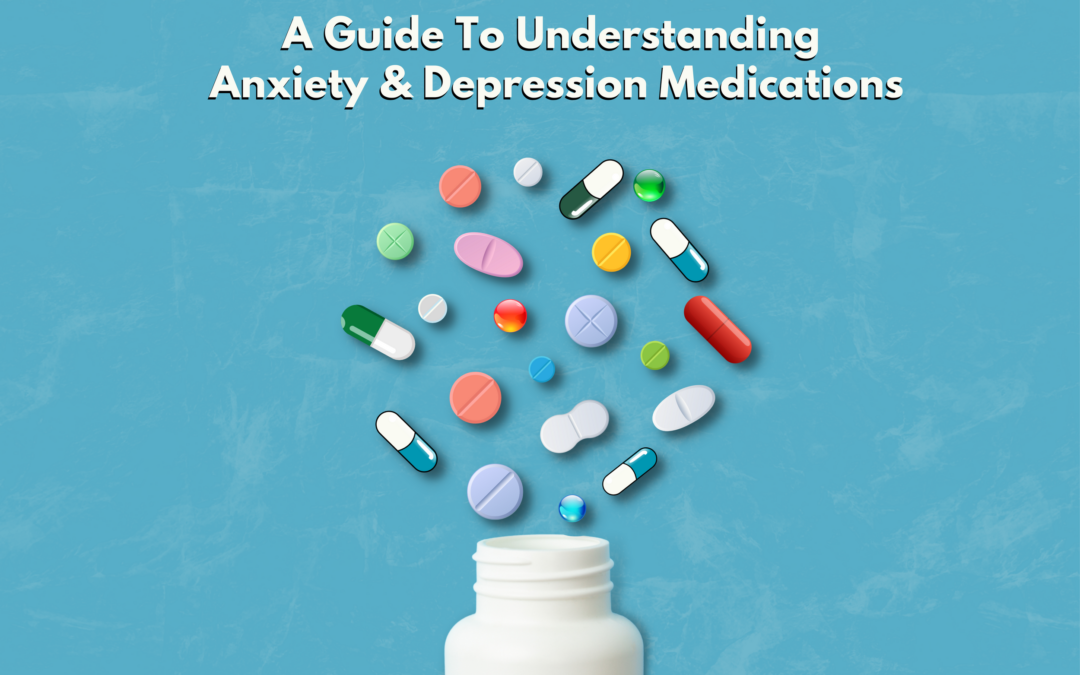Medications often play a crucial role in the treatment of anxiety and depressive disorders. This blog post aims to provide an overview of the most commonly prescribed medications for anxiety and depressive disorders, highlighting their differences in mechanisms of action, indications, potential side effects, and considerations for treatment selection. By understanding these distinctions, both people seeking treatment and healthcare professionals can make informed decisions, optimize therapeutic outcomes, and foster collaborative treatment approaches.
Selective Serotonin Reuptake Inhibitors (SSRIs)
Ex. Fluoxetine (Prozac), Sertraline (Zoloft), Escitalopram (Lexapro), Paroxetine (Paxil), Citalopram (Celexa)
SSRIs are the most commonly prescribed class of psychiatric medications. These medications work by increasing the amount of serotonin, a neurotransmitter involved in mood regulation, transmitted within the brain. While they share a similar mechanism of action, each SSRI medication has distinct properties, such as its half-life, metabolism, potential drug interactions, and side effect profile. These variations allows healthcare professionals to tailor treatments to each person’s specific needs.
Serotonin-Norepinephrine Reuptake Inhibitors (SNRIs)
Ex. Venlafaxine (Effexor), Duloxetine (Cymbalta), Desvenlafaxine (Pristiq), Levomilnacipran (Fetzima)
SNRIs, like SSRIs, increase the levels of serotonin in the brain. However, they also target norepinephrine, another neurotransmitter involved in mood regulation.. Similar to SSRIs, SNRIs differ in their properties, potential side effects, and dosing considerations.
Benzodiazepines
Ex. Alprazolam (Xanax), Diazepam (Valium), Lorazepam (Ativan), Clonazepam (Klonopin)
Benzodiazepines are a class of medications commonly used for the short-term management of anxiety disorders. They work by enhancing the effects of gamma-aminobutyric acid (GABA), a neurotransmitter that helps reduce anxiety and promote relaxation. Benzodiazepines provide rapid relief from symptoms but are typically prescribed for short durations due to the risk of dependence and potential side effects, such as sedation and cognitive impairment. Each benzodiazepine also has specific properties, including its onset of action, duration of effect, and potential for drug interactions.
Buspirone
Buspirone is an anxiolytic medication prescribed for the long-term management of generalized anxiety disorder (GAD). It works by selectively binding to serotonin receptors in the brain, modulating their activity. Buspirone differs from benzodiazepines in its mechanism of action and lack of sedative properties. It is considered a non-habit-forming alternative for people who prefer non-benzodiazepine treatments or have concerns about the potential for dependence.
Tricyclic Antidepressants (TCAs)
Ex. Amitriptyline, Imipramine, Nortriptyline, Clomipramine
TCAs were among the earliest classes of antidepressant medications developed. Although they are less commonly prescribed today, they can still be effective in managing depression, anxiety disorders, and certain chronic pain conditions. TCAs work by inhibiting the reuptake of serotonin and norepinephrine, increasing their availability in the brain. Each TCA within the class has unique properties, including varying affinity for receptors, potential side effects, and considerations for specific indications.
Atypical Antidepressants
Ex. Bupropion (Wellbutrin), Mirtazapine (Remeron), Trazodone (Desyrel), Vilazodone (Viibryd)
Atypical antidepressants comprise a diverse group of medications that do not fit neatly into other categories. Bupropion primarily affects dopamine and norepinephrine, making it a suitable option for people with co-existing depression and concerns about sexual side effects. Mirtazapine and trazodone offer sedating properties and may be beneficial for people with insomnia or weight loss associated with depression. Vilazodone is a newer medication that combines selective serotonin reuptake inhibition with partial agonism of serotonin receptors, offering a unique approach to managing depression.
In Summary
The most common medications prescribed for anxiety and depressive disorders include SSRIs, SNRIs, benzodiazepines, buspirone, TCAs, and atypical antidepressants, but choosing the appropriate medication requires careful consideration of multiple factors. Each class of medications offers unique benefits, mechanisms of action, potential side effects, and considerations for individualized treatment selection.
It is crucial to note that peoples’ responses to medications can vary, and treatment choices should be based on a thorough assessment by a qualified healthcare professional. Additionally, it is also important to recognize that medication is just one component of a comprehensive treatment approach for anxiety and depressive disorders. Other interventions, such as therapy, lifestyle modifications, and support systems, can all significantly enhance overall outcomes as well.


Recent Comments